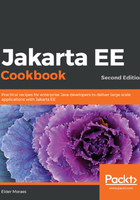
What this book covers
Chapter 1, New Features and Improvements, explains the main changes to the Jakarta EE 8 specification and what you can do with them. It also shows the new features and briefly explores the benefits of them. All these topics are supported by code examples.
Chapter 2, Server-Side Development, deep-dives into the most important APIs and the most commonly used features for server-side development. You will go through real recipes for solving real problems.
Chapter 3, Building Powerful Services with JSON and RESTful Features, creates web services for different enterprise scenarios. You will go deep into the JAX-RS, JSON-P, and JSON-B APIs.
Chapter 4, Web- and Client-Server Communication, deals with the communication generated by web applications in a fast and reliable way using the latest Jakarta EE 8 features, such as HTTP2 and Server Push.
Chapter 5, Security of Enterprise Architecture, gives you information on various tools using the best Jakarta EE features to create secure architectures.
Chapter 6, Reducing the Coding Effort by Relying on Standards, describes the services and features that Jakarta EE application servers give to the applications they host. Those features not only enable you to rely on a standard and build your application based on it, but also allow you to write less code, as you don't need to implement features that have already been implemented by the server.
Chapter 7, Deploying and Managing Applications on Major Jakarta EE Servers, describes the use of each of the most commonly used Jakarta EE application servers on the market, giving special attention to the way you deploy and manage them.
Chapter 8, Building Lightweight Solutions Using Microservices, helps you to understand how microservice architectures work and how you can easily use Jakarta EE 8 to build microservices and/or break down your monoliths in order to implement this paradigm.Continuous delivery and continuous deployment are also described, as no successful microservice project is complete without a mature building and deployment process.
Chapter 9, Using Multithreading on Enterprise Context, describes the use of multithreading and concurrency when building enterprise applications.
Chapter 10, Using Event-Driven Programming to Build Reactive Applications, describes the use of Jakarta EE 8 and core Java to create low-latency, efficient, and high-throughput applications.
Chapter 11, Rising to the Cloud – Jakarta EE, Containers, and Cloud Computing, describes how to combine Jakarta EE and containers to run applications on the cloud.
Appendix, The Power of Sharing Knowledge, describes how the community is vital for the whole Jakarta EE ecosystem (even if you don't know about it), and looks at how you can improve your own daily work by joining the Adopt a JSR initiative.
The chapter also describes how sharing knowledge is a powerful tool for improving your career and explains what it has to do with Jakarta EE (it has everything to do with Jakarta EE!).